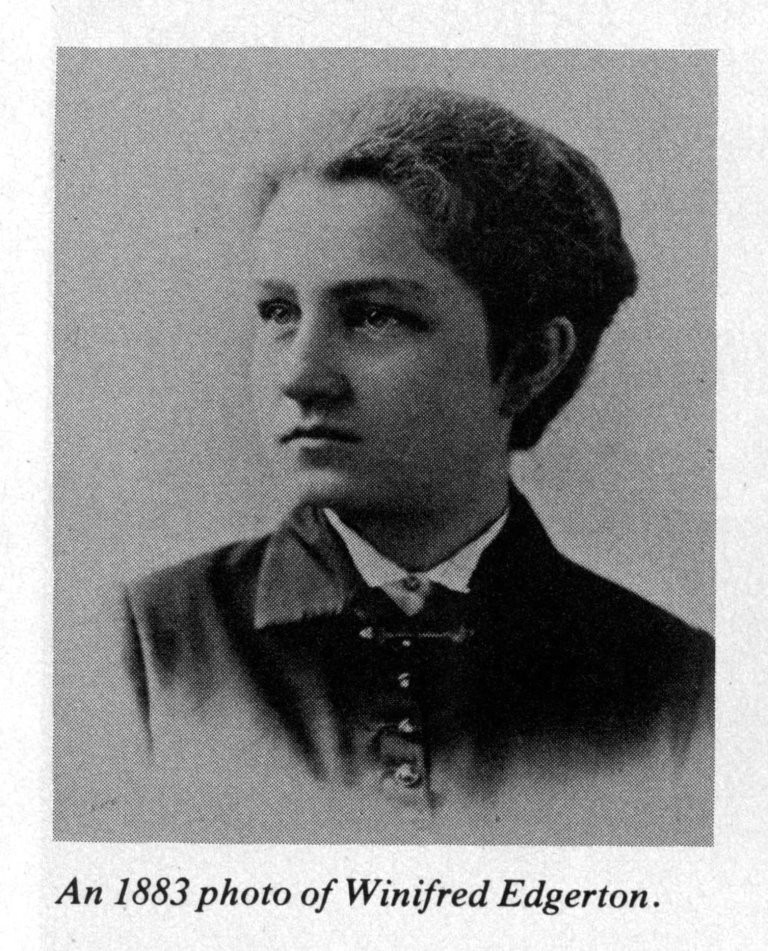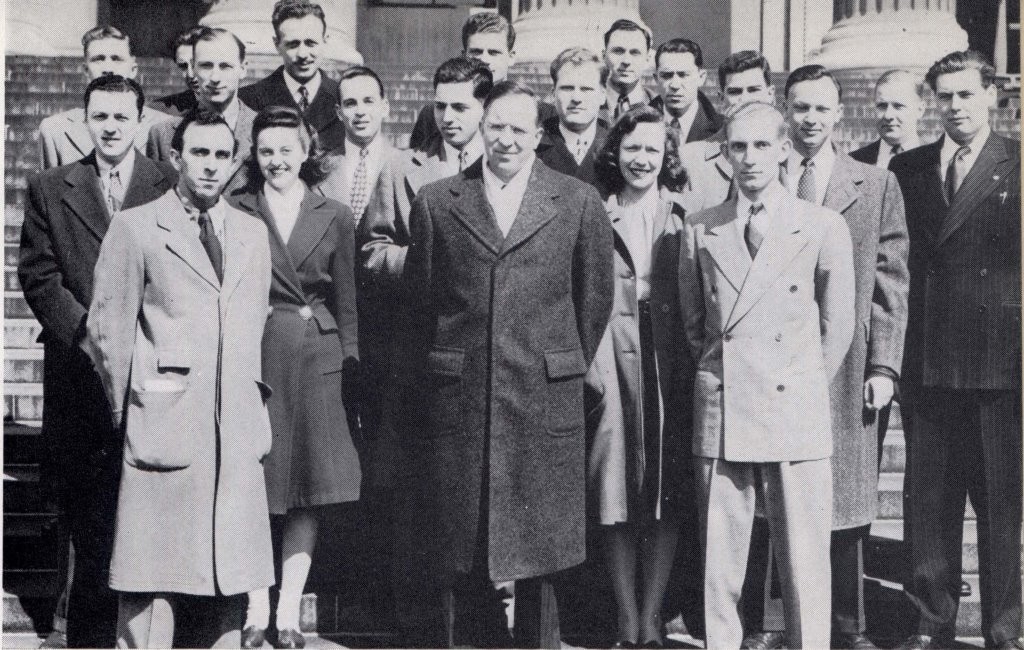Coeducation at Columbia
Coeducation in the Graduate Programs, 1884-1942
The battle over women’s undergraduate education at Columbia was a highly publicized, contested one, and ended not with coeducation but with the establishment of Barnard College. By contrast, with much less fanfare but no less determination, women gained admission to Columbia’s graduate and professional schools at a steady rate throughout the late nineteenth and early twentieth centuries.
Ironically, while the debate over the Collegiate Course occupied the Board of Trustees during the 1880s, the Board agreed to admit a promising female scholar to study Astronomy and Mathematics. Originally turned down in 1883, Winifred Edgerton, a young Wellesley graduate, finally convinced the Board of Trustees – and Reverend Morgan Dix himself – that she deserved admission to Columbia to pursue her graduate degree. The case was also a matter of expediency: then Adjunct Professor John Krom Reese, who would serve as Edgerton’s mentor, needed a graduate assistant as much as Edgerton needed a place to conduct her research. The Board recognized the advantages of the situation and relented in January of 1884. In his diary, Dix assured himself that “the case was of an absolutely exceptional nature, and established no precedent for others.” [1]
- Overview
- The Struggle Begins
- Collegiate Course for Women
- Establishing Barnard
- Coeducation in Graduate Schools
- Coed at Last
- Bibliography
Edgerton proved to be an exceptional student, and when she finished her Doctoral work in 1886, Dix himself moved that the young woman be awarded her Ph.D. cum laude. “She fully deserves it,” he concluded. Upon graduation, Smith College offered Edgerton a professorship, but she turned it down to marry Frederick James Hamilton Merrill, PhB 1885, PhD 1890. So ended Edgerton’s promising academic career. [2]
But other women followed the path that Edgerton had blazed, defying Dix’s claim that the female astronomer had “established no precedent” for other women. Though it remained quite difficult for women to gain admission to Columbia’s graduate and professional schools, women did gain admission and attend Columbia at a steadily increasing rate.
In 1895, the Faculty of Philosophy voted to admit female graduate students and qualified Barnard undergraduates to their courses, with the permission of the instructor. In 1897, the Faculty of Pure Sciences followed suit. John Burgess’s Faculty of Political Sciences agreed to admit women in 1898, but only because then-President of the University Seth Low convinced Burgess that a wealthy benefactor would fund a new Political Science professorship if women were allowed to attend the School’s courses. (Later, Burgess discovered that that “benefactor” was President Low himself). In 1900, Teachers College affiliated with Columbia, thus adding a significant number of women to its matriculation list.
As the University expanded, so too did the opportunities for women seeking professional training. Columbia’s School of Journalism, established in 1912, began admitting women at the outset. When the Columbia Business School opened its doors a few years later in 1916, eight out of a class of sixty-one students were women. [3]
Entry to the established professional schools proved more difficult. Both the Law School and the School of Physicians and Surgeons remained all-male into the twentieth century. The School of Physicians agreed to admit women in 1917, following a drop in student enrollment. The Law School grudgingly followed suit in 1927, after ten years of petitioning by activists and leading New York lawyers. Each of the first students at these schools, moreover, were impeccably qualified, and handpicked by Barnard’s dean, Virginia Gildersleeve. One of the first female law students, for example, had graduated Barnard and received her Ph.D. from Columbia University. [4]
By 1927, then, almost every professional school, save the Engineering School, admitted women. In August of that year, the New York World reported that more women than men attended Columbia University and its affiliate schools during the 1926-1927 school year. [5]
The School of Engineering finally began admitting women in 1942; again, it went coed based on need rather than principle. World War II had depleted factories of many of its engineers. In response, Columbia began training women in advanced chemistry and metallurgy courses. The program remained a permanent one because administrators predicted that demands for women engineers would continue to rise after the war. [6]
By the postwar era, Columbia’s campus looked very different from the one over which Reverend Dix and his Board presided in the late nineteenth century. Women made up a significant number of students in the graduate and professional schools, and attended many of the classes offered on campus. Only Columbia College remained all male. As with the University’s graduate schools, the financial and academic needs of the College, rather than the demands of activists, would fuel the push for coeducation at the undergraduate level.
[1] Rosalind Rosenberg, “’The Woman Question’ at Columbia: From John W. Burgess to Judith Shapiro” Delivered at the Columbia University Seminar on the History of the University, February 17, 1999; Morgan Dix Diary, excerpts pertaining to Columbia College, compiled by Roger Howson, 1856-1906, Friday, January 18, 1884. Columbiana Manuscripts, University Archives, Rare Book & Manuscript Library, Columbia University in the City of New York.
[2] Morgan Dix Diary, excerpts pertaining to Columbia College, compiled by Roger Howson, 1856-1906, Monday, June 7, 1886, Columbiana Manuscripts; Rosenberg, “The Woman Question.”
 [3] Women: Graduate Study. Historical Subject Files, University Archives, Rare Book & Manuscript Library, Columbia University in the City of New York.
[3] Women: Graduate Study. Historical Subject Files, University Archives, Rare Book & Manuscript Library, Columbia University in the City of New York.
 [4] Robert McCaughey, Stand Columbia: A History of Columbia University in the City of New York, 1754-2004. (New York: Columbia University Press, 2003), 511; Women: Graduate Study. Historical Subject Files.
[4] Robert McCaughey, Stand Columbia: A History of Columbia University in the City of New York, 1754-2004. (New York: Columbia University Press, 2003), 511; Women: Graduate Study. Historical Subject Files.
 [5] Women: Graduate Study. Historical Subject Files.
[5] Women: Graduate Study. Historical Subject Files.
[6] Women: Graduate Study. Historical Subject Files.

